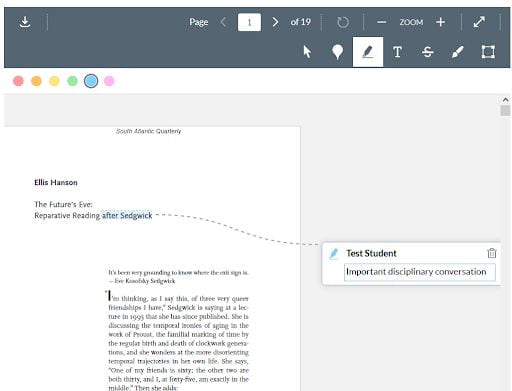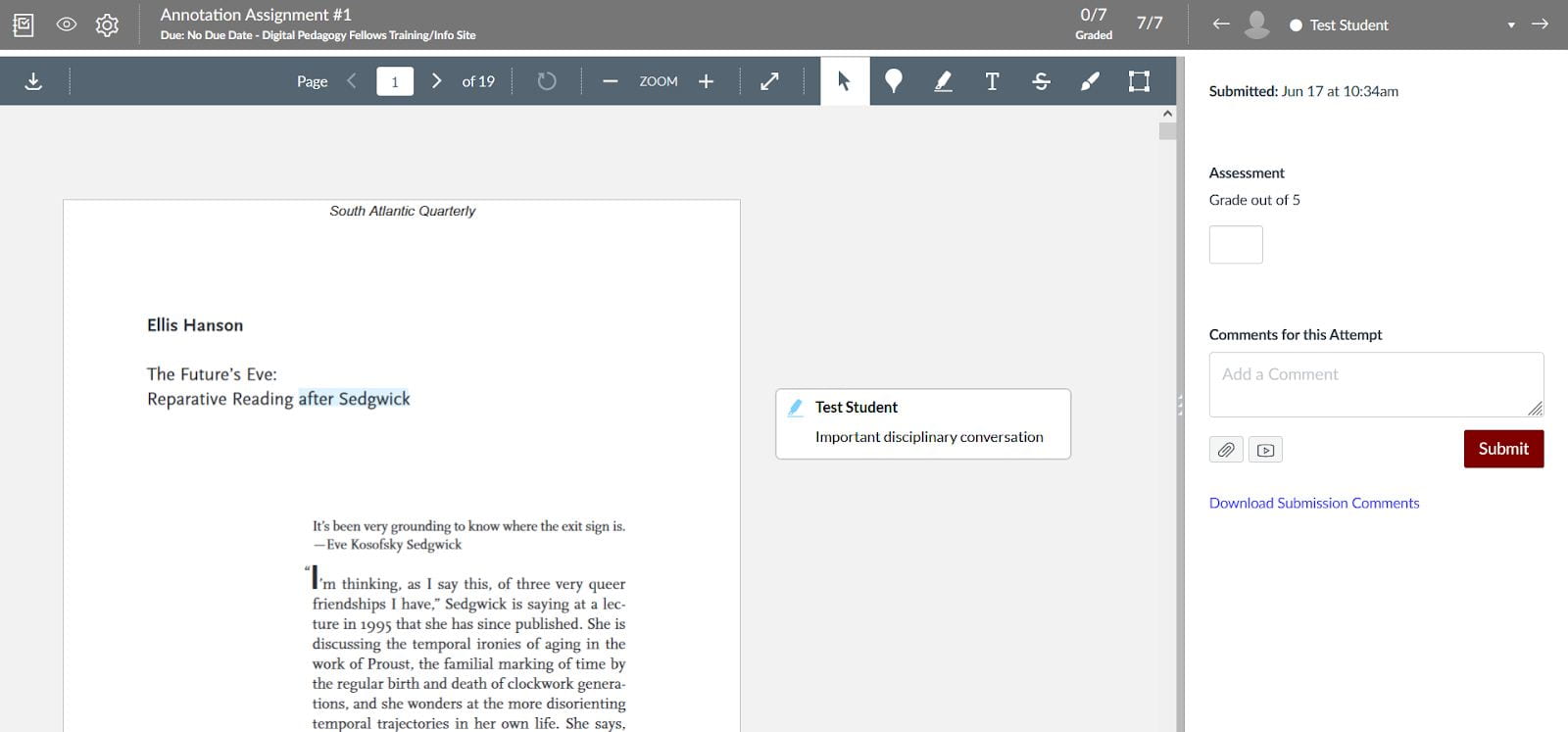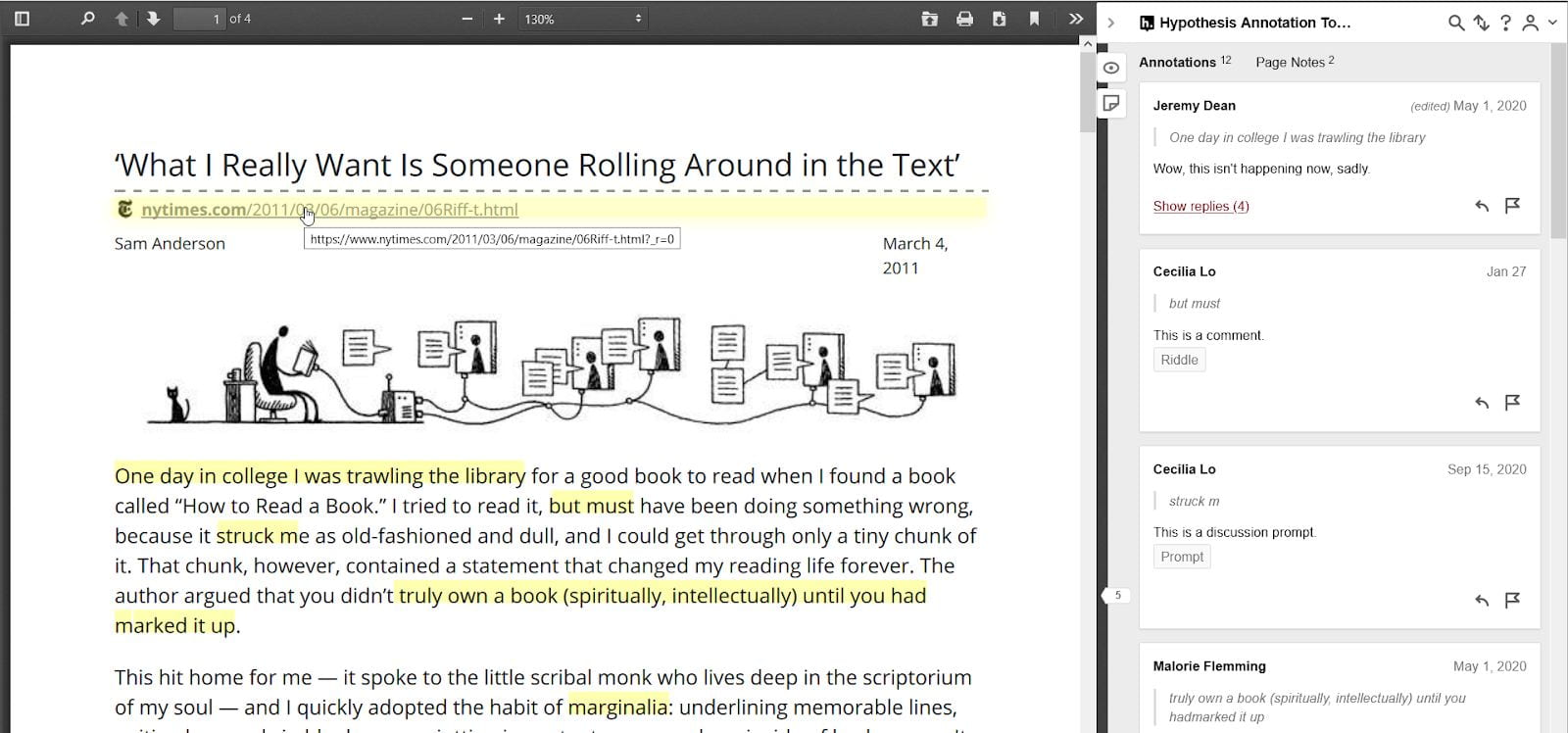With an updated release of Canvas that launched in mid-May, instructors now have access to an additional Assignment format on Canvas: Student Annotation Assignments. With the addition of Student Annotation Assignments to the suite of resources supported through Canvas, instructors can now make use of two distinct platforms for student annotation assignments and activities, which can be tailored to distinct instructional contexts and learning objectives.
In this post, we will explore two frameworks for student annotation and close-reading exercises – individual annotations, completed independently by students, and social or group annotations, which students generate collectively – and consider which digital annotation tools best suit each purpose. Additionally, we will provide an overview of the new Student Annotation Assignment format and a recommended workflow for designing assignments that make use of it.
I. Student Annotation Assignments on Canvas
Features of Canvas Annotation Assignments
As a new Assignment format native to the Canvas learning management system, Student Annotation Assignments enable instructors to design assignments that ask students to annotate text- and image-based documents using a variety of annotation features also available to instructors in SpeedGrader. When working with an Annotation Assignment, students have access to a highlighting tool (to select text), a rectangular area selection tool (to select an area of the document), a pin marker (to mark a point of focus at a specific location in the document), a freehand drawing tool, a text box tool, and a strikethrough tool.

In addition, when making use of any of these text selection or modification tools, students can type out marginal comments that describe or reflect on their annotation choices.

Once students have completed their annotations, they click the maroon “Submit Assignment” button to save their work and deliver their annotated version of the document to the instructor through Canvas.

Students are also able to download their annotations – an annotated copy of the document – through the annotation toolbar.

Pedagogical Context for Canvas Annotation Assignments: Individual Work
As the Student View perspective shown above indicates, Canvas Annotation Assignments are designed for independent use by individual students. In brief, students open such assignments as they would any other on Canvas, begin an assignment attempt (by clicking “Start Assignment”), and access an unannotated copy of the original document uploaded by the instructor to begin their annotations. Each student, in other words, accesses a fresh copy of the document and creates and submits annotations that are visible only to the instructor.
As a result, Canvas Annotation Assignments are not effectively suited to group annotation work, for the simple reason that annotations are generated and submitted on an individual rather than a collaborative basis. However, individual annotation exercises – performed individually by students and submitted to the instructor for assessment – have a wide variety of instructional uses across the disciplines and can be used to help students prepare for group annotation work.
In the language-learning classroom, for example, individual annotation exercises represent one streamlined way to assess students’ reading comprehension skills (asking students to make translations, highlight particular parts of speech or grammatical structures, paraphrase passages, and raise comprehension or discussion questions responsive to the text) while challenging students to develop their fluency as readers, writers, and speakers through tasks that work through layers of cognitive complexity.
Across humanities and social sciences classrooms, individual annotation exercises can enable instructors to gain insight into and assess their students’ use of interpretive strategies and modalities through targeted reading exercises that challenge students to generate observations about a text or document, develop an argument or thesis about it, and gather evidence to support that thesis from their initial observations – an activity that could either precede the drafting of an argumentative essay or serve as a standalone exercise to develop the scaffolding for an argumentative essay.
In a variety of STEM contexts, individual annotation exercises can challenge students to represent their thinking and their work clearly in response to problems and questions – that is, to elucidate and emphasize the process of their problem-solving in addition to the solutions, products, and outcomes they ultimately generate.
Creating Canvas Annotation Assignments: Workflow for Instructors
For instructors, creating Canvas Annotation Assignments is just as straightforward as creating any other Canvas Assignment:
- We recommend uploading to your Canvas site the file you wish students to annotate before creating your Annotation Assignment. You may do so by navigating to the Files tab and uploading files there. This helps prevent occasional hiccups in correctly linking the Canvas Assignment with the file.
- Create a new Assignment, then click Edit to configure it.

- In the Submission Type dropdown menu, select Online submission; then select the checkbox for Student Annotations. Click on the link to Course files, and select the document you wish to use for this assignment. PDFs, .docx files, and most image files are compatible with Canvas Annotation Assignments.

- Click the Save or Save & Publish button to save your work.

Grading Student Annotation Assignments
After students have attempted and submitted this assignment, you can view, assess, and provide feedback for student work using SpeedGrader. In opening each student’s submission, you will be able to view all annotations, mark-up, and comments the student generated.


II. Hypothes.is Integration on Canvas
A second format for student annotation activities and assignments on Canvas is the social annotation platform Hypothes.is, available for instructor use through the Canvas – Hypothes.is integration. As a platform designed specifically to support the work of social annotation, Hypothes.is is ideally suited to collaborative, group-based exercises in reading and annotation.
Unlike with Canvas Annotation Assignments, Hypothes.is activities and assignments are visible by default to all members of a Canvas site; as students contribute annotations, these become visible to their colleagues, who are then able to respond to and comment on the observations and ideas that have been shared. Instructors at UChicago have found that Hypothes.is activities are a good way to promote students’ engagement with each other, to encourage discussions of close reading, and to make the reading process more transparent.
To access Hypothes.is activities in Canvas, students click on the name of the activity (under Modules or Assignments) and load a new tab that displays the document undergoing annotation. The Canvas – Hypothes.is integration makes use of a collapsible annotation applet that loads on the right-hand side of this tab.

An additional important difference between Canvas Annotation Assignments and Hypothes.is lies in the way that annotations are saved and the document formats that are supported. Canvas Annotation Assignments make use of an image-based overlay process, incorporating student highlights, comments, and other modifications onto approximated locations in the document. Hypothes.is, on the other hand, makes use of Optical Character Recognition (OCR) to tie annotations and highlights – the two annotation strategies available to students – to particular characters or strings of characters in the document. Accordingly, Canvas Annotation Assignments are compatible with a variety of file formats (.pdf, .docx, .png, .jpeg) and enable students to produce annotations on non-textual features of a document (such as images, diagrams, and interstitial space), while Hypothes.is can be used to annotate web pages and PDFs for annotation and does not support the annotation of non-textual features of a document. Annotations produced through Canvas Annotation Assignments can thus at times be less precise (not tied to specific characters) than those generated in Hypothes.is (which are highly portable across browsers and devices because they are tied to specific characters), while Canvas Annotation Assignments allow for the annotation of additional non-textual features.
Instructors at UChicago have found creative ways to respond to the affordances and limitations of each platform; for an in-depth exploration of faculty use of Hypothes.is and social annotation at UChicago, please see “Social Annotation and the Pedagogy of Hypothes.is” on the Academic Technology Solutions blog. For a comprehensive treatment of the technical specifications and steps required to implement Hypothes.is in Canvas, as well as effective practices for its use, please see “Use the Hypothesis-Canvas Integration” on the UChicago IT Knowledge Base.
If you have any questions about Canvas Annotation Assignments, Hypothes.is, digital annotation, or other topics in Canvas, Academic Technology Solutions can help. Set up a consultation with us, or drop by our Virtual Office Hours.
Resources
- How do I annotate a file as an assignment submission in Canvas? (Canvas student guide)
- Student Annotation Submissions (Canvas instructor video)
- Use the Hypothesis-Canvas Integration
- Social Annotation and the Pedagogy of Hypothes.is
(Featured photo by Aaron Burden on Unsplash )
